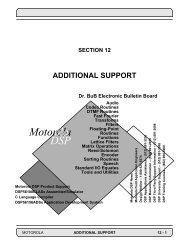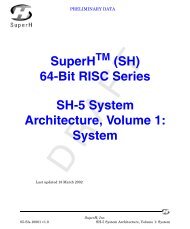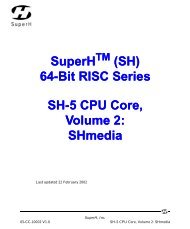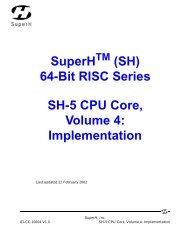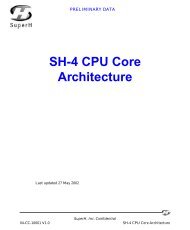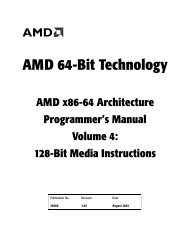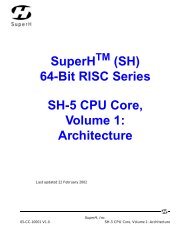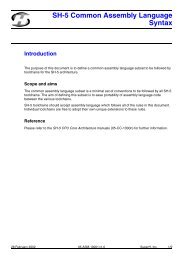- Page 1 and 2: PRELIMINARY DATA SuperH TM (SH) 64-
- Page 3 and 4: PRELIMINARY DATA Contents Preface 9
- Page 5 and 6: PRELIMINARY DATA 5 1.8.11 DM.TRBUF
- Page 7 and 8: PRELIMINARY DATA 7 3.2.5 Pin state
- Page 9 and 10: PRELIMINARY DATA Preface This docum
- Page 11 and 12: PRELIMINARY DATA Debug/trace archit
- Page 13 and 14: PRELIMINARY DATA Overview of debug
- Page 15 and 16: PRELIMINARY DATA Key concepts 15 Th
- Page 17: PRELIMINARY DATA Key concepts 17 Ac
- Page 21 and 22: PRELIMINARY DATA Key concepts 21 1.
- Page 23 and 24: PRELIMINARY DATA Key concepts 23 La
- Page 25 and 26: PRELIMINARY DATA Key concepts 25 {W
- Page 27 and 28: PRELIMINARY DATA Key concepts 27 If
- Page 29 and 30: PRELIMINARY DATA Key concepts 29 Re
- Page 31 and 32: PRELIMINARY DATA CPU control 31 1.3
- Page 33 and 34: PRELIMINARY DATA CPU control 33 1.3
- Page 35 and 36: PRELIMINARY DATA Watchpoint channel
- Page 37 and 38: PRELIMINARY DATA Watchpoint channel
- Page 39 and 40: PRELIMINARY DATA Watchpoint channel
- Page 41 and 42: PRELIMINARY DATA Watchpoint channel
- Page 43 and 44: PRELIMINARY DATA Watchpoint channel
- Page 45 and 46: PRELIMINARY DATA Watchpoint channel
- Page 47 and 48: PRELIMINARY DATA Watchpoint channel
- Page 49 and 50: PRELIMINARY DATA Debug event action
- Page 51 and 52: PRELIMINARY DATA Debug event action
- Page 53 and 54: PRELIMINARY DATA Debug event action
- Page 55 and 56: PRELIMINARY DATA Debug event action
- Page 57 and 58: PRELIMINARY DATA Debug event action
- Page 59 and 60: PRELIMINARY DATA Debug event action
- Page 61 and 62: PRELIMINARY DATA Debug event action
- Page 63 and 64: PRELIMINARY DATA Debug event action
- Page 65 and 66: PRELIMINARY DATA Debug event action
- Page 67 and 68: PRELIMINARY DATA WP channel matchin
- Page 69 and 70:
PRELIMINARY DATA WP channel matchin
- Page 71 and 72:
PRELIMINARY DATA WP channel matchin
- Page 73 and 74:
PRELIMINARY DATA Reset, panic and d
- Page 75 and 76:
PRELIMINARY DATA Reset, panic and d
- Page 77 and 78:
PRELIMINARY DATA Reset, panic and d
- Page 79 and 80:
PRELIMINARY DATA Reset, panic and d
- Page 81 and 82:
PRELIMINARY DATA Reset, panic and d
- Page 83 and 84:
PRELIMINARY DATA Reset, panic and d
- Page 85 and 86:
PRELIMINARY DATA Debug module 85 DM
- Page 87 and 88:
PRELIMINARY DATA Debug module 87
- Page 89 and 90:
PRELIMINARY DATA Debug module 89 Wh
- Page 91 and 92:
PRELIMINARY DATA Debug module 91 St
- Page 93 and 94:
PRELIMINARY DATA Debug module 93 Mu
- Page 95 and 96:
PRELIMINARY DATA Debug module 95 1.
- Page 97 and 98:
PRELIMINARY DATA Debug module 97 1.
- Page 99 and 100:
PRELIMINARY DATA Debug module 99 DM
- Page 101 and 102:
PRELIMINARY DATA Debug module 101 D
- Page 103 and 104:
PRELIMINARY DATA Debug module 103 D
- Page 105 and 106:
PRELIMINARY DATA Debug module 105 D
- Page 107 and 108:
PRELIMINARY DATA Debug module 107 1
- Page 109 and 110:
PRELIMINARY DATA Debug module 109 D
- Page 111 and 112:
PRELIMINARY DATA Debug module 111 D
- Page 113 and 114:
PRELIMINARY DATA Debug module 113
- Page 115 and 116:
PRELIMINARY DATA Debug module 115 D
- Page 117 and 118:
PRELIMINARY DATA Debug module 117 1
- Page 119 and 120:
PRELIMINARY DATA Debug protocols an
- Page 121 and 122:
PRELIMINARY DATA Debug protocols an
- Page 123 and 124:
PRELIMINARY DATA Debug protocols an
- Page 125 and 126:
PRELIMINARY DATA Debug protocols an
- Page 127 and 128:
PRELIMINARY DATA Debug protocols an
- Page 129 and 130:
PRELIMINARY DATA Debug protocols an
- Page 131 and 132:
PRELIMINARY DATA Debug protocols an
- Page 133 and 134:
PRELIMINARY DATA Debug protocols an
- Page 135 and 136:
PRELIMINARY DATA Debug protocols an
- Page 137 and 138:
PRELIMINARY DATA WP channel type BR
- Page 139 and 140:
PRELIMINARY DATA WP channel type IA
- Page 141 and 142:
PRELIMINARY DATA WP channel type IA
- Page 143 and 144:
PRELIMINARY DATA WP channel type OA
- Page 145 and 146:
PRELIMINARY DATA WP channel type OA
- Page 147 and 148:
PRELIMINARY DATA WP channel type OA
- Page 149 and 150:
PRELIMINARY DATA WP channel type OA
- Page 151 and 152:
PRELIMINARY DATA WP channel type OA
- Page 153 and 154:
PRELIMINARY DATA WP channel type IV
- Page 155 and 156:
PRELIMINARY DATA WP channel type IV
- Page 157 and 158:
PRELIMINARY DATA WP channel type BR
- Page 159 and 160:
PRELIMINARY DATA WP channel type BR
- Page 161 and 162:
PRELIMINARY DATA WP channel type BR
- Page 163 and 164:
PRELIMINARY DATA WP channel type FP
- Page 165 and 166:
PRELIMINARY DATA WP channel type WP
- Page 167 and 168:
PRELIMINARY DATA WP channel type WP
- Page 169 and 170:
PRELIMINARY DATA WP channel type WP
- Page 171 and 172:
PRELIMINARY DATA WP channel type WP
- Page 173 and 174:
PRELIMINARY DATA WP channel type WP
- Page 175 and 176:
PRELIMINARY DATA WP channel type WP
- Page 177 and 178:
PRELIMINARY DATA WP channel type WP
- Page 179 and 180:
PRELIMINARY DATA SuperHyway bus ana
- Page 181 and 182:
PRELIMINARY DATA SuperHyway watchpo
- Page 183 and 184:
PRELIMINARY DATA Address comparison
- Page 185 and 186:
PRELIMINARY DATA Freezing bus maste
- Page 187 and 188:
PRELIMINARY DATA WP channel type PL
- Page 189 and 190:
PRELIMINARY DATA WP channel type PL
- Page 191 and 192:
PRELIMINARY DATA WP channel type PL
- Page 193 and 194:
PRELIMINARY DATA WP channel type PL
- Page 195 and 196:
PRELIMINARY DATA WP channel type PL
- Page 197 and 198:
PRELIMINARY DATA WP channel type PL
- Page 199 and 200:
PRELIMINARY DATA External debug int
- Page 201 and 202:
PRELIMINARY DATA SHdebug link 201 3
- Page 203 and 204:
PRELIMINARY DATA SHdebug link 203 3
- Page 205 and 206:
PRELIMINARY DATA SHdebug link 205 T
- Page 207 and 208:
PRELIMINARY DATA SHdebug link 207 D
- Page 209 and 210:
PRELIMINARY DATA SHdebug link 209 3
- Page 211 and 212:
PRELIMINARY DATA SHdebug link 211 3
- Page 213 and 214:
PRELIMINARY DATA JTAG interface 213
- Page 215 and 216:
PRELIMINARY DATA JTAG interface 215
- Page 217 and 218:
PRELIMINARY DATA JTAG interface 217
- Page 219 and 220:
PRELIMINARY DATA Debug tool reset/s
- Page 221 and 222:
PRELIMINARY DATA Debug tool reset/s
- Page 223 and 224:
PRELIMINARY DATA Debug tool reset/s
- Page 225 and 226:
PRELIMINARY DATA Trigger functions
- Page 227 and 228:
PRELIMINARY DATA DBUS protocol 227
- Page 229 and 230:
PRELIMINARY DATA DBUS protocol 229
- Page 231 and 232:
PRELIMINARY DATA DBUS protocol 231
- Page 233 and 234:
PRELIMINARY DATA DBUS protocol 233
- Page 235 and 236:
PRELIMINARY DATA DBUS protocol 235
- Page 237 and 238:
PRELIMINARY DATA DBUS protocol 237
- Page 239 and 240:
PRELIMINARY DATA DBUS protocol 239
- Page 241 and 242:
PRELIMINARY DATA Implementation spe
- Page 243 and 244:
PRELIMINARY DATA Scalable parameter
- Page 245 and 246:
PRELIMINARY DATA Scalable parameter
- Page 247 and 248:
PRELIMINARY DATA Scalable parameter
- Page 249 and 250:
PRELIMINARY DATA Scalable parameter
- Page 251 and 252:
PRELIMINARY DATA Scalable parameter
- Page 253 and 254:
PRELIMINARY DATA Debug register add
- Page 255 and 256:
PRELIMINARY DATA Debug register add
- Page 257 and 258:
PRELIMINARY DATA Debug register add
- Page 259 and 260:
PRELIMINARY DATA Debug register add
- Page 261 and 262:
PRELIMINARY DATA Debug register add
- Page 263 and 264:
PRELIMINARY DATA Debug register add
- Page 265 and 266:
PRELIMINARY DATA Index A Actions 13
- Page 267 and 268:
PRELIMINARY DATA 267 244, . . . . .
- Page 269 and 270:
PRELIMINARY DATA 269 158-160, 166-1



